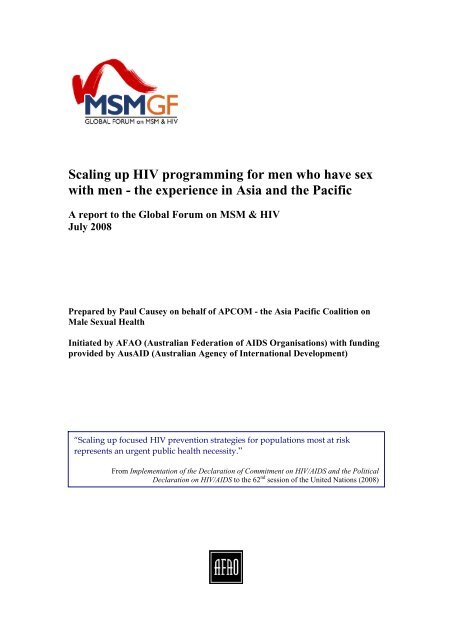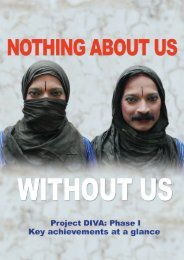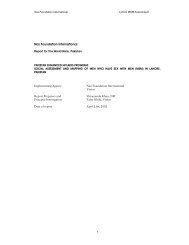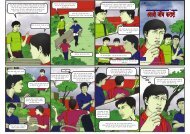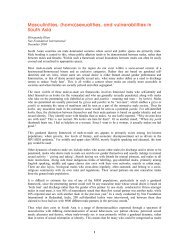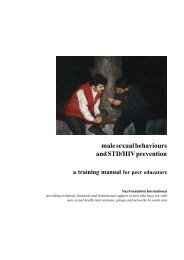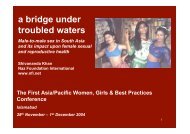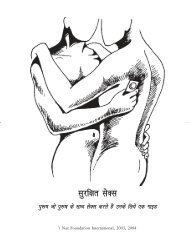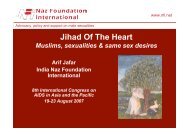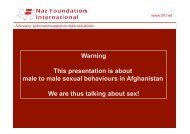Scaling up HIV programming for men who have sex ... - apcom.org
Scaling up HIV programming for men who have sex ... - apcom.org
Scaling up HIV programming for men who have sex ... - apcom.org
Create successful ePaper yourself
Turn your PDF publications into a flip-book with our unique Google optimized e-Paper software.
<strong>Scaling</strong> <strong>up</strong> <strong>HIV</strong> <strong>programming</strong> <strong>for</strong> <strong>men</strong> <strong>who</strong> <strong>have</strong> <strong>sex</strong><br />
with <strong>men</strong> - the experience in Asia and the Pacific<br />
A report to the Global Forum on MSM & <strong>HIV</strong><br />
July 2008<br />
Prepared by Paul Causey on behalf of APCOM - the Asia Pacific Coalition on<br />
Male Sexual Health<br />
Initiated by AFAO (Australian Federation of AIDS Organisations) with funding<br />
provided by AusAID (Australian Agency of International Develop<strong>men</strong>t)<br />
“<strong>Scaling</strong> <strong>up</strong> focused <strong>HIV</strong> prevention strategies <strong>for</strong> populations most at risk<br />
represents an urgent public health necessity.”<br />
From Imple<strong>men</strong>tation of the Declaration of Commit<strong>men</strong>t on <strong>HIV</strong>/AIDS and the Political<br />
Declaration on <strong>HIV</strong>/AIDS to the 62 nd session of the United Nations (2008)
Table of Contents<br />
Acknowledge<strong>men</strong>ts ......................................................................................................3<br />
Commonly used abbreviations and acronyms ..........................................................5<br />
Introduction..................................................................................................................6<br />
Situation of MSM and <strong>HIV</strong> in Asia and the Pacific..................................................7<br />
History – Conception to Inception..............................................................................9<br />
Planning and preparation .........................................................................................10<br />
The need <strong>for</strong> data .......................................................................................................11<br />
Involve<strong>men</strong>t of the United Nations system ..............................................................13<br />
Imple<strong>men</strong>tation phase ...............................................................................................14<br />
Results of the processes .............................................................................................16<br />
Recom<strong>men</strong>dations on starting a process – expert advice.......................................18<br />
Recom<strong>men</strong>dations on initiating a planning process ...............................................19<br />
1. Analyze the local and regional situation carefully......................................19<br />
2. Identify key individuals <strong>who</strong> might serve as ‘champions’ <strong>for</strong> the process<br />
from a variety of sectors - civil society, of course, but govern<strong>men</strong>t, donors<br />
and technical experts from INGO, as well...................................................19<br />
3. Establish a time-based work plan with divisions of labour and<br />
responsibilities clearly defined......................................................................20<br />
4. Production of the meeting itself is crucial <strong>for</strong> the success and must be<br />
carefully planned............................................................................................20<br />
Recom<strong>men</strong>dations on working with donors ............................................................20<br />
Conclusion: joining together works .........................................................................21<br />
<strong>Scaling</strong> <strong>up</strong> <strong>HIV</strong> <strong>programming</strong> <strong>for</strong> <strong>men</strong> <strong>who</strong> <strong>have</strong> <strong>sex</strong> with <strong>men</strong> - the experience in Asia and the Pacific<br />
Page 2 of 23
Acknowledge<strong>men</strong>ts<br />
MSM <strong>HIV</strong> <strong>programming</strong> in the Asia and Pacific region has advanced more rapidly<br />
over the last three to five years compared with other regions with predominantly low<br />
and middle income countries. This paper is the result of a regional meeting of<br />
technical experts held in May 2008 in Bangkok, Thailand. Each of these individuals<br />
has unique direct professional experience and involve<strong>men</strong>t in one or all aspects of the<br />
processes that are believed to <strong>have</strong> aided these advances in <strong>HIV</strong> <strong>programming</strong> <strong>for</strong><br />
MSM in Asia and the Pacific.<br />
Special gratitude is hereby extended to each individual <strong>for</strong> their participation and<br />
s<strong>up</strong>port of this meeting in order to identify, docu<strong>men</strong>t and systematically discuss the<br />
key factors, strategies and activities underlying this progress. This critical in<strong>for</strong>mation<br />
is intended to be shared with MSM activists, program planners and govern<strong>men</strong>t<br />
officials in other regions. The participants in the Bangkok meeting are listed below<br />
with their current professional affiliations followed by which aspect of the Asia<br />
Pacific scale <strong>up</strong> experience they were (or are) a part of:<br />
1. Aditya Bondyopadhyay, Coordinator, APCOM; RR/APCOM + MSM-GF<br />
2. Asia Nguyen, Programme Officer - Coordination, UNAIDS Viet Nam; GMS<br />
3. Clif<strong>for</strong>d Cortez JD, Senior Technical Advisor <strong>HIV</strong>/AIDS, USAID Asia;<br />
GMS & RR/APCOM<br />
4. Don Baxter, Executive Director, AFAO; GMS & RR/APCOM + MSM-GF<br />
5. Edmund Settle, <strong>HIV</strong>/AIDS Programme Manager, UNDP China; GMS &<br />
RR/APCOM<br />
6. Indrajit Pandey, Programme Officer, UNAIDS RST AP; RR/APCOM<br />
7. Philippe Girault, Senior Technical Officer, Male Sexual Health Program,<br />
FHI/APRO, GMS & RR/APCOM<br />
8. Rob Sutherland, Capacity Develop<strong>men</strong>t Officer – MSM; UNAIDS RST AP,<br />
9. Dr. Ruben del Prado, Country Coordinator <strong>for</strong> Guyana and Suriname,<br />
UNAIDS; RR/APCOM + MSM-GF<br />
10. Shivananda Khan OBE, Chief Executive, NFI; GMS & RR/APCOM +<br />
MSM-GF<br />
11. Paul Causey, Consultant, APCOM (MSM-GF/AFAO); GMS & RR/APCOM<br />
12. Charles Clay, Consultant, Logistics and Meeting Recorder<br />
<strong>Scaling</strong> <strong>up</strong> <strong>HIV</strong> <strong>programming</strong> <strong>for</strong> <strong>men</strong> <strong>who</strong> <strong>have</strong> <strong>sex</strong> with <strong>men</strong> - the experience in Asia and the Pacific<br />
Page 3 of 23
Additional thanks are extended to Patrick Chong, Deputy Director, US-CDC Asia<br />
Regional Office Global AIDS Program, <strong>for</strong> his early work in Vietnam helping to<br />
<strong>org</strong>anise and bring attention to MSM and <strong>HIV</strong> in the region, and <strong>for</strong> assistance in<br />
editing this paper. This paper and its planned follow <strong>up</strong> activities are all part of the<br />
work of the Global Forum on MSM and <strong>HIV</strong> (MSM-GF; see also<br />
www.msm&hiv.<strong>org</strong>), and has been made possible with leadership and funding s<strong>up</strong>port<br />
provided by the Australian Federation of AIDS Organisations (AFAO) and the<br />
Australian Agency of International Develop<strong>men</strong>t (AusAID).<br />
The paper was principally authored by Paul Causey, <strong>who</strong> also helped coordinate, <strong>for</strong><br />
FHI-APRO, both the early work in the Greater Mekong Sub-region and the<br />
International Coalition on Male Sexual Health and <strong>HIV</strong>/AIDS in Asia and the Pacific,<br />
(Risk and Responsibilities). He is currently a consultant to the Asia Pacific Coalition<br />
on Male Sexual Health (APCOM) and participated in the start <strong>up</strong> of the Secretariat<br />
operations and the APCOM website at www.msmasia.<strong>org</strong>.<br />
For additional in<strong>for</strong>mation about the Asia Pacific Experience, including copies of<br />
reports <strong>men</strong>tioned in this paper, contact either of the Secretariat offices below:<br />
Purple Sky Network<br />
Siam Arayawongchai, Coordinator, MSM Program<br />
TREAT Asia<br />
Exchange Tower<br />
21st floor, suite 2104<br />
388 Sukhumvit Road, Klong Toey<br />
Bangkok 10110 Thailand<br />
Telephone: +66 (0) 2663 7561<br />
Fax: +66 (0) 2663 7562<br />
Email: jack.arayawongchai@treatasia.<strong>org</strong><br />
Asia Pacific Coalition on Male Sexual Health<br />
Aditya Bondyopadhyay, Secretariat Coordinator<br />
11/4 A 1st Floor, Double Story Area<br />
Prem Nagar, Janakpuri<br />
New Delhi-110075 India<br />
Telephone: +91-11-6510-7911<br />
Email: adityab@msmasia.<strong>org</strong><br />
<strong>Scaling</strong> <strong>up</strong> <strong>HIV</strong> <strong>programming</strong> <strong>for</strong> <strong>men</strong> <strong>who</strong> <strong>have</strong> <strong>sex</strong> with <strong>men</strong> - the experience in Asia and the Pacific<br />
Page 4 of 23
Commonly used abbreviations and acronyms<br />
ADB .......................... Asian Develop<strong>men</strong>t Bank<br />
AFAO ........................... Australian Federation of AIDS Organizations<br />
AIDS ........................ Acquired Immune Deficiency Syndrome<br />
amfAR....................... American Foundation <strong>for</strong> AIDS Research<br />
APCOM .................... Asia Pacific Coalition on Male Sexual Health<br />
APN+............................ Asia Pacific Network of People Living with <strong>HIV</strong>/AIDS<br />
APNSW ........................ Asia Pacific Network of Sex Workers<br />
ART/ARV ................ antiretroviral therapy or treat<strong>men</strong>t/antiretroviral drugs<br />
ASEAN ..................... Association of Southeast Asian Nations<br />
CBO ......................... community-based <strong>org</strong>anization(s)<br />
CDC .......................... China Centre <strong>for</strong> Disease Control and Prevention<br />
CSO ............................. civil society <strong>org</strong>anization(s)<br />
DFID ......................... Depart<strong>men</strong>t <strong>for</strong> International Develop<strong>men</strong>t (UK)<br />
FHI-ARPO.................... Family Health International - Asia Regional Program Office<br />
FSW.............................. female <strong>sex</strong> workers<br />
GMS.......................... Greater Mekong Sub-region<br />
<strong>HIV</strong> .......................... Human Immunodeficiency Virus<br />
Hivos......................... Humanist Institute <strong>for</strong> Cooperation with Developing Countries<br />
HPI/RTI..................... Health Policy Initiatives/Research Triangle Institute<br />
ICAAP....................... International Congress on AIDS in Asia Pacific<br />
IDU ........................... injection drug user<br />
ILO............................ International Labour Organisation<br />
INGO ........................ international nongovern<strong>men</strong>tal <strong>org</strong>anization(s)<br />
MARP........................... most at risk populations<br />
MSM ........................ <strong>men</strong> <strong>who</strong> <strong>have</strong> <strong>sex</strong> with <strong>men</strong><br />
MSM-GF................... Global Forum on MSM & <strong>HIV</strong><br />
NFI ............................ Naz Foundation International (UK)<br />
NGO ......................... nongovern<strong>men</strong>tal <strong>org</strong>anization(s)<br />
PL<strong>HIV</strong> ...................... person or people living with <strong>HIV</strong> include those with AIDS<br />
PSN ........................... Purple Sky Network<br />
RR ............................. Risks and Responsibilities – International Consultation on Male<br />
Sexual Health and <strong>HIV</strong>/AIDS in Asia and the Pacific<br />
RTI ............................ Research Triangle Institute<br />
STI ............................ <strong>sex</strong>ually transmitted infection(s)<br />
TAF........................... Technical S<strong>up</strong>port Facility<br />
UN ............................ United Nations<br />
UNAIDS ................... Joint United Nations Programme on <strong>HIV</strong>/AIDS<br />
UNAIDS RST AP..... UNAIDS Regional S<strong>up</strong>port Team - Asia and the Pacific<br />
UNDP........................ United Nations Develop<strong>men</strong>t Programme<br />
UNDP RBAP ............ UNDP Regional Bureau Asia and the Pacific<br />
UNESCO ..................... United Nations Educational, Scientific and Cultural<br />
Organization<br />
UNFPA ..................... United Nations Populations Fund<br />
USAID ...................... United States Agency <strong>for</strong> International Develop<strong>men</strong>t<br />
US-CDC.................... The Centers <strong>for</strong> Disease Control and Prevention (USA)<br />
WHO ........................ World Heath Organization<br />
<strong>Scaling</strong> <strong>up</strong> <strong>HIV</strong> <strong>programming</strong> <strong>for</strong> <strong>men</strong> <strong>who</strong> <strong>have</strong> <strong>sex</strong> with <strong>men</strong> - the experience in Asia and the Pacific<br />
Page 5 of 23
…“it’s the epidemiology.” … in low and concentrated <strong>HIV</strong> epidemics … MSM is a<br />
critical part of transmission dynamics … many in this region, including govern<strong>men</strong>t<br />
representatives, are committed to the reduction of <strong>HIV</strong> in MSM because MSM are an<br />
important epidemiological factor relative to <strong>HIV</strong>/AIDS, as experience has shown in other<br />
parts of the world.<br />
From Report from <strong>HIV</strong> Prevention and Care Interventions <strong>for</strong> MSM in the<br />
Greater Mekong Sub-region Regional Consultative Forum (2006)<br />
Introduction<br />
Increased attention to <strong>HIV</strong> epidemics among <strong>men</strong> <strong>who</strong> <strong>have</strong> <strong>sex</strong> with <strong>men</strong> (MSM) 1 in<br />
middle and low income countries can be seen in the publication of new studies and<br />
research. These epidemics are now docu<strong>men</strong>ted to be underway in Asia, Africa, the<br />
Caribbean, Latin America, and the <strong>for</strong>mer Soviet Union states of Eastern Europe.<br />
Many of these <strong>HIV</strong>/ MSM epidemics share common traits in addition to mere mode<br />
of transmission. These commonalities exacerbate or indirectly contribute to the<br />
problem, and include criminalization of male to male <strong>sex</strong>ual activity (MMSA), social<br />
exclusion from mainstream healthcare systems including infection control planning<br />
and services, societal stigma and discrimination against same <strong>sex</strong> ‘orientations’ which<br />
are regarded as non-mainstream, exclusion from human rights initiatives and<br />
protections, and lack of comprehensive <strong>HIV</strong> surveillance. i ii<br />
In Asia and the Pacific, response to <strong>HIV</strong> infection among MSM was nearly nonexistent<br />
until after the year 2000. General discom<strong>for</strong>t with the fact of <strong>sex</strong> among <strong>men</strong><br />
in Asia meant govern<strong>men</strong>t and national AIDS programme priorities usually did not<br />
include data <strong>for</strong> this gro<strong>up</strong> prior to the year 2000. As a result, the logic of a vicious<br />
circle was followed - no data meant there must be no problem; there<strong>for</strong>e, no<br />
interventions including research or surveillance were undertaken, which assured there<br />
would be no docu<strong>men</strong>t of need or risk behaviours, and so <strong>for</strong>th.<br />
There is now, though, data available <strong>for</strong> most countries along with increases in<br />
programmatic responses in some areas. Inclusion of MSM as a ‘most at risk<br />
population’ (MARP) now exists and MSM and <strong>HIV</strong> <strong>programming</strong> in the region has<br />
advanced more rapidly over the last three to five years when compared to regions with<br />
similar low and middle income countries. As well, the recently released report of the<br />
independent Commission on AIDS in Asia in March 2008 stated clearly that ef<strong>for</strong>ts to<br />
halt the Asia <strong>HIV</strong> epidemic must now focus on high risk behaviours occurring chiefly<br />
among three sub-populations – female <strong>sex</strong> workers (FSW), injection drug users (IDU)<br />
and <strong>men</strong> <strong>who</strong> <strong>have</strong> <strong>sex</strong> with <strong>men</strong>. iii<br />
This paper intends to help understand what made the difference in Asia and the<br />
Pacific <strong>for</strong> increased attention to MSM and <strong>HIV</strong>. There is wide agree<strong>men</strong>t in the<br />
region that two processes, one sub-regional and one region-wide, <strong>have</strong> provided a<br />
framework and context which both strengthened MSM advocacy <strong>for</strong> improving the<br />
response to <strong>HIV</strong> and allowed most national govern<strong>men</strong>ts in the region to s<strong>up</strong>port – or<br />
1 “Men <strong>who</strong> <strong>have</strong> <strong>sex</strong> with <strong>men</strong>” (MSM) ) is an inclusive public health term used to define the <strong>sex</strong>ual behaviours<br />
of males having <strong>sex</strong> with other males, regardless of gender identity, motivation <strong>for</strong> engaging in <strong>sex</strong> or<br />
identification with any or no particular ‘community’. The words 'man' and '<strong>sex</strong>' are interpreted differently in<br />
diverse cultures and societies as well as by the individuals involved. As a result, the term MSM covers a large<br />
variety of settings and contexts in which male to male <strong>sex</strong> takes place. (APCOM 2008)<br />
<strong>Scaling</strong> <strong>up</strong> <strong>HIV</strong> <strong>programming</strong> <strong>for</strong> <strong>men</strong> <strong>who</strong> <strong>have</strong> <strong>sex</strong> with <strong>men</strong> - the experience in Asia and the Pacific<br />
Page 6 of 23
at least not to oppose or s<strong>up</strong>press – the develop<strong>men</strong>t of <strong>HIV</strong> programmes <strong>for</strong> MSM.<br />
The two processes culminated in the creation of, respectively, the Purple Sky<br />
Network, a coordination ef<strong>for</strong>t <strong>for</strong> MSM and <strong>HIV</strong> interventions in the Greater<br />
Mekong Sub-region (GMS), and the Asia Pacific Coalition on Male Sexual Health<br />
(APCOM). The contributions by these two processes to the scale <strong>up</strong> of <strong>HIV</strong><br />
interventions and the work needed to achieve it are referred to in this paper as “the<br />
Asia Pacific Experience”.<br />
The Global Forum on MSM & <strong>HIV</strong> (MSM-GF) convened a meeting of 12 technical<br />
experts in April 2008 in Bangkok, Thailand to discuss and docu<strong>men</strong>t the two<br />
processes. Most of these participants had been involved in the start <strong>up</strong> and<br />
imple<strong>men</strong>tation of either or both of the processes and many continue to s<strong>up</strong>port both<br />
of them in their work. As well, all continue to be directly involved in work to improve<br />
and increase universal access to <strong>HIV</strong> services <strong>for</strong> MSM and transgenders, among<br />
others.<br />
The Bangkok meeting set two critical objectives:<br />
1. To provide a space <strong>for</strong> the critical reflection, clarification and docu<strong>men</strong>tation<br />
of effective advocacy strategies and techniques contributing to improved<br />
MSM <strong>programming</strong> in the Asia Pacific region.<br />
2. To provide MSM programme activists and s<strong>up</strong>porters, particularly from<br />
Africa, Central Asia and Eastern Europe, with a range of well-considered and<br />
potentially useful strategies and techniques to build mo<strong>men</strong>tum <strong>for</strong> MSM<br />
<strong>programming</strong> and to help overcome resistance from authorities and<br />
gatekeepers.<br />
This paper is intended to be taken to MSM activists, programme planners and,<br />
hopefully, govern<strong>men</strong>t officials in other regions, to learn from, adopt and adapt the<br />
lessons of the Asia Pacific Experience. It is hoped that this work will inspire<br />
community leaders, govern<strong>men</strong>t policy makers and international donors alike to<br />
consider how best to assist in the scale <strong>up</strong> of timely and evidenced-based interventions<br />
in the accelerating global <strong>HIV</strong> epidemics among MSM.<br />
Situation of MSM and <strong>HIV</strong> in Asia and the Pacific<br />
The incidence of male to male <strong>sex</strong> is known to happen in every country of the Asia<br />
Pacific region yet in most countries it is largely denounced, ignored or disregarded by<br />
mainstream society. In some countries, same <strong>sex</strong> activity is criminalised by laws held<br />
over mostly from the time of colonial rule. This situation has led to a lack of public<br />
health attention to the needs of this sub-population, including <strong>HIV</strong> interventions<br />
which strategically focus on prevention, treat<strong>men</strong>t, care and s<strong>up</strong>port <strong>for</strong> MSM.<br />
The 2008 report from the Commission on AIDS in Asia estimates that at least 75% of<br />
<strong>HIV</strong> infections in the region can be linked directly to high risk behaviours occurring<br />
during <strong>sex</strong> between <strong>men</strong>, female <strong>sex</strong> work and injecting drugs. Moreover, the<br />
Commission used a well-proven projection model to calculate what might happen if<br />
current epidemiological trends continue in this atmosphere of neglect. It revealed that<br />
<strong>Scaling</strong> <strong>up</strong> <strong>HIV</strong> <strong>programming</strong> <strong>for</strong> <strong>men</strong> <strong>who</strong> <strong>have</strong> <strong>sex</strong> with <strong>men</strong> - the experience in Asia and the Pacific<br />
Page 7 of 23
50% of all new infections in the region will be among MSM by 2020, outnumbering<br />
<strong>HIV</strong> infections caused by the other two sub-population gro<strong>up</strong>s. iv<br />
From Redefining AIDS in Asia - Crafting an Effective Response,<br />
Commission on AIDS in Asia (2008)<br />
A 2006 survey of the coverage of <strong>HIV</strong> interventions in 15 Asia Pacific countries<br />
estimated that targeted prevention programmes reached less than 8% of the estimated<br />
number of MSM, v whereas 80% coverage is needed to effectively reduce the<br />
incidence of <strong>HIV</strong> infections. vi Substantial <strong>HIV</strong> epidemics among MSM are now well<br />
docu<strong>men</strong>ted in urban areas across Asia, with <strong>HIV</strong> prevalence rates of 30.7% in<br />
Bangkok (2007) vii ; 15.6% in Maharashtra State (2007) v ; 12.3% in New Delhi<br />
(2007) viii ; 8.7% in Phnom Penh (2005) ix ; and 5.8 % in Beijing (2007) x . Despite these<br />
findings indicating that <strong>HIV</strong> prevalence among MSM is <strong>up</strong> to 50 times higher than<br />
prevalence among general population adults and contributes to between 10 and 25%<br />
of the total number of <strong>HIV</strong> cases in several countries, invest<strong>men</strong>t in <strong>HIV</strong><br />
<strong>programming</strong> <strong>for</strong> MSM remains very low (0%-4% of the total spending <strong>for</strong> <strong>HIV</strong><br />
<strong>programming</strong> region-wide xi ). xii<br />
Although coverage of <strong>HIV</strong> services <strong>for</strong> MSM in Asia and the Pacific continues to be<br />
very low, it has been dramatically increased from the almost zero attention in 2000 to<br />
<strong>Scaling</strong> <strong>up</strong> <strong>HIV</strong> <strong>programming</strong> <strong>for</strong> <strong>men</strong> <strong>who</strong> <strong>have</strong> <strong>sex</strong> with <strong>men</strong> - the experience in Asia and the Pacific<br />
Page 8 of 23
now. Largely responsible <strong>for</strong> this increase are the two processes, the Asia Pacific<br />
Experience, s<strong>up</strong>porting and leading advocacy and scale <strong>up</strong> in Asia Pacific. The Purple<br />
Sky Network serves as a focal point <strong>for</strong> advocacy, s<strong>up</strong>port and coordination in the<br />
Greater Mekong Sub-region. The Asia Pacific Coalition on Male Sexual Health<br />
(APCOM) is a collective comprised of representatives from MSM communities and<br />
gro<strong>up</strong>s involved in <strong>HIV</strong> work, the govern<strong>men</strong>t sector, donor and develop<strong>men</strong>t<br />
agencies, INGO technical experts and the UN system. Both initiatives <strong>have</strong> provided a<br />
framework and context to <strong>HIV</strong> among MSM, which strengthened MSM advocacy <strong>for</strong><br />
improving the response to <strong>HIV</strong> and allowed many national and local govern<strong>men</strong>ts in<br />
the region to better understand and s<strong>up</strong>port – or at least not directly oppose or<br />
s<strong>up</strong>press – the develop<strong>men</strong>t of <strong>HIV</strong> <strong>programming</strong> <strong>for</strong> <strong>men</strong> <strong>who</strong> <strong>have</strong> <strong>sex</strong> with <strong>men</strong>.<br />
History – Conception to Inception<br />
Not until 2006 were MSM included in any national AIDS control plans in Asia and<br />
the Pacific – at best, they had been <strong>men</strong>tioned under broad categories with other highrisk<br />
populations. There had been, however, some in<strong>for</strong>mation on male-to-male <strong>sex</strong><br />
collected in countries in the GMS, South Asia and Indonesia that provided some<br />
unpleasant surprises: high levels of unprotected anal <strong>sex</strong>, very low use of or access to<br />
water-based lubricants, and high levels of <strong>HIV</strong> infection rates. xiii<br />
These findings had led to some progress in designing and imple<strong>men</strong>ting pilot<br />
programmes <strong>for</strong> prevention and care programmes <strong>for</strong> MSM in most of the urban areas<br />
where the research was conducted, but other possible “hotspots” with significant<br />
male-to-male <strong>sex</strong>ual vulnerability to <strong>HIV</strong> (and <strong>sex</strong>ually transmitted infections (STI))<br />
were highly suspected but remained undocu<strong>men</strong>ted. As a result, of course, these<br />
hotspots also lacked targeted interventions.<br />
There also was no agree<strong>men</strong>t or research to guide the type and methodology of<br />
interventions or services that would best be provided to MSM in the region. In<br />
Vietnam, an MSM sub-gro<strong>up</strong> of the Technical Working Gro<strong>up</strong> on <strong>HIV</strong>/AIDS had<br />
started meeting in 2004, which led to a discussion of <strong>HIV</strong> among MSM in the GMS at<br />
an <strong>HIV</strong> and drug use meeting in Cambodia at which govern<strong>men</strong>t officials and civil<br />
society were both present. It was felt by those at the meeting, in discussing the early<br />
reports, that the few data available should be used to “wake people <strong>up</strong> about MSM<br />
and <strong>HIV</strong> in the GMS.”<br />
A meeting was undertaken and the GMS <strong>HIV</strong> and MSM process (referred to here as<br />
the GMS process) began with two United States govern<strong>men</strong>t donor agencies, the US<br />
Centers <strong>for</strong> Disease Control and Prevention Global AIDS Program (CDC-GAP) and<br />
United States Agency <strong>for</strong> International Develop<strong>men</strong>t Regional Develop<strong>men</strong>t Mission<br />
(USAID-RDMA), and the international non-govern<strong>men</strong>t <strong>org</strong>anisation (INGO) Family<br />
Health International Asia Regional Program (FHI-ARP). The process was to start with<br />
a workshop to assess the extent of <strong>HIV</strong> and MSM in the six Greater Mekong countries<br />
(Cambodia, China (Yunnan and Guangxi provinces), Laos, Thailand, Vietnam and<br />
Myanmar/Burma), and to decide on a minimum comprehensive package, or<br />
conceptual framework, of interventions <strong>for</strong> MSM, which could also be used as a<br />
framework <strong>for</strong> policymaking and monitoring and evaluating programmes.<br />
<strong>Scaling</strong> <strong>up</strong> <strong>HIV</strong> <strong>programming</strong> <strong>for</strong> <strong>men</strong> <strong>who</strong> <strong>have</strong> <strong>sex</strong> with <strong>men</strong> - the experience in Asia and the Pacific<br />
Page 9 of 23
In South Asia, and particularly in India, there is a long history of civil society,<br />
including community <strong>org</strong>anising among lesbian, gay, bi<strong>sex</strong>ual and transgender<br />
(LGBT) people. In 1994, an historic national conference <strong>for</strong> gay <strong>men</strong> was held in<br />
Mumbai and key leaders were empowered to begin addressing many of the issues<br />
facing gay <strong>men</strong> at that time, including <strong>HIV</strong> among MSM. Humsafar Trust and Naz<br />
Foundation International (NFI) began developing and s<strong>up</strong>porting <strong>HIV</strong> <strong>programming</strong><br />
<strong>for</strong> gay <strong>men</strong> and MSM, together with transgenders (hijras and kothis), in India and<br />
Bangladesh, and soon afterwards in Nepal and Sri Lanka. Several sub-regional and<br />
provincial meetings were held in the late 1990s and early in the new century, which<br />
were by and <strong>for</strong> MSM civil society but always included members from both the donor<br />
and govern<strong>men</strong>t sectors, although most often only as observers rather than “official”<br />
representatives.<br />
At a meeting in 2004 during the International AIDS Conference in Bangkok,<br />
Thailand, the idea <strong>for</strong> a pan-regional consultation on MSM and <strong>HIV</strong> was first<br />
conceived. The INGO Naz Foundation International (NFI) solicited s<strong>up</strong>port from<br />
UNAIDS, both the Regional S<strong>up</strong>port Team (RST) <strong>for</strong> Asia Pacific and the India<br />
office, and WHO India to <strong>for</strong> its sponsorship of what was to become the International<br />
Consultation on Male Sexual Health and AIDS in Asia and the Pacific, Risks and<br />
Responsibilities (referred to here as the RR process). Significant encourage<strong>men</strong>t and<br />
enthusiasm was also given by key donors, particularly DFID and USAID, early on<br />
(over 20 international donor agencies and INGO s<strong>up</strong>ported the RR meeting).<br />
These earlier meetings, mostly in<strong>for</strong>mal and amongst friends and colleagues, helped<br />
to stimulate local communities and leaders alike to begin initiatives intended to drive<br />
the scale <strong>up</strong> of <strong>HIV</strong> <strong>programming</strong> <strong>for</strong> MSM using international pressure. Both<br />
processes, the GMS coordination and the RR international consultation, were<br />
designed from the beginning to include govern<strong>men</strong>t partners. And both took the<br />
approach to focus on the facts as they was known at that time. In response to the<br />
question as to why donors and INGO were beginning to take notice and s<strong>up</strong>port <strong>HIV</strong><br />
interventions among MSM in the GMS, one donor participant in one of the GMS<br />
workshops stated, “It’s the right thing to do… after all, it’s the epidemiology [of<br />
<strong>HIV</strong>].” He elaborated that in low and concentrated <strong>HIV</strong> epidemics as in the GMS,<br />
MSM is a critical part of transmission dynamics and that the reduction of <strong>HIV</strong> in is an<br />
important epidemiological factor relative to <strong>HIV</strong>/AIDS, as experience has shown in<br />
other parts of the world. xiv<br />
“…although nearly all countries <strong>have</strong> national strategic frameworks addressing<br />
populations most at risk, fewer than half <strong>have</strong> imple<strong>men</strong>ted <strong>HIV</strong> prevention<br />
services focused on injecting drug users, <strong>men</strong> <strong>who</strong> <strong>have</strong> <strong>sex</strong> with <strong>men</strong> or <strong>sex</strong><br />
workers in all or most districts in need.”<br />
From Imple<strong>men</strong>tation of the Declaration of Commit<strong>men</strong>t on <strong>HIV</strong>/AIDS and the<br />
Political Declaration on <strong>HIV</strong>/AIDS to the 62 nd session of the United Nations (2008)<br />
Planning and preparation<br />
The beginning of the GMS coordination process was largely donor driven because<br />
there were so few civil society <strong>org</strong>anisations (CSO) involved in the work at the time.<br />
The sponsoring agencies created a technical advisory committee that included other<br />
<strong>Scaling</strong> <strong>up</strong> <strong>HIV</strong> <strong>programming</strong> <strong>for</strong> <strong>men</strong> <strong>who</strong> <strong>have</strong> <strong>sex</strong> with <strong>men</strong> - the experience in Asia and the Pacific<br />
Page 10 of 23
INGO, mostly those receiving US govern<strong>men</strong>t s<strong>up</strong>port <strong>for</strong> community <strong>HIV</strong><br />
<strong>programming</strong>, and UNESCO (later expanded to include UNAIDS RST). Likewise,<br />
NFI, the sponsor of RR, created a similar committee with the addition of local MSM<br />
community leaders and opened a secretariat office in New Delhi to handle all logistics<br />
<strong>for</strong> the meeting, planned to be <strong>up</strong> to 400 people from all parts of Asia and the Pacific.<br />
The first workshop of the GMS coordination process invited over 50 regional experts<br />
from INGO and community-based <strong>org</strong>anisations (CBO) but also from govern<strong>men</strong>ts, to<br />
present and discuss the implications of the recent research. The participants were<br />
charged with creating a plan of action to effectively respond to the <strong>HIV</strong> epidemics<br />
among MSM in the sub-region, to propose a minimum set of <strong>HIV</strong> interventions, and<br />
prioritise scale <strong>up</strong> <strong>for</strong> known and suspected hotspots. There was recognition that this<br />
ef<strong>for</strong>t could not be driven only by donors, that civil society <strong>org</strong>anisations had to be<br />
developed or strengthened in order to take the lead. The workshop ended with<br />
agree<strong>men</strong>t that a consensus was needed from a larger gro<strong>up</strong> of people, especially<br />
additional community and govern<strong>men</strong>t representatives from each country, where<br />
possible. A second larger meeting was planned <strong>for</strong> six months later.<br />
In contrast, the beginning of the RR process was led by community leaders,<br />
specifically from NFI as described be<strong>for</strong>e, but broadened to include other key leaders<br />
from all parts of the Asia Pacific region and particularly from India and South Asia,<br />
where friction between community gro<strong>up</strong>s and individuals is fairly commonplace.<br />
One donor has stated that it was this broad alliance of community gro<strong>up</strong>s and their<br />
leaders, joining together <strong>for</strong> the RR planning and imple<strong>men</strong>tation, which allowed<br />
continuing and additional s<strong>up</strong>port <strong>for</strong> the RR process.<br />
An RR steering committee was assembled to guide content and programme design.<br />
The committee met only twice be<strong>for</strong>e the consultation meeting began but worked<br />
electronically via emails, including intense editing of docu<strong>men</strong>ts during programme<br />
develop<strong>men</strong>t. The overarching principle of RR, similar to the GMS, was that the<br />
meeting should be community-led but at all levels be tripartite, bringing together three<br />
diverse parts of the <strong>HIV</strong> response that do not often regard one another as equals –<br />
community/civil society including activists (those involved or invested in MSM and<br />
<strong>HIV</strong> work and issues), govern<strong>men</strong>t officials (national AIDS and <strong>HIV</strong> control<br />
specialists and epidemiologists), and researchers, technical experts and academics<br />
(including representatives from the UN system) with direct experience in MSM and<br />
<strong>HIV</strong> issues. Further, unlike most international meetings, the steering committee set<br />
the very high standard of insisting that everyone attending, other than the technical<br />
experts, would be fully s<strong>up</strong>ported to attend – travel and accommodations were to be<br />
fully paid by the meeting itself – and the meeting would be conducted <strong>for</strong> free to all<br />
invited, including lunch, dinner and tea breaks. The thinking behind this idea was<br />
simple: “Make it more difficult to say ‘no’.”<br />
The need <strong>for</strong> data<br />
The most current research available in each country or area was recognised as the first<br />
place to start, programmatically, in both of the processes. There<strong>for</strong>e, both collected<br />
and reviewed data on these key categories:<br />
• <strong>HIV</strong> prevalence among MSM<br />
• Estimation of the size of the population of MSM<br />
<strong>Scaling</strong> <strong>up</strong> <strong>HIV</strong> <strong>programming</strong> <strong>for</strong> <strong>men</strong> <strong>who</strong> <strong>have</strong> <strong>sex</strong> with <strong>men</strong> - the experience in Asia and the Pacific<br />
Page 11 of 23
• Identification of <strong>HIV</strong> interventions <strong>for</strong> MSM underway<br />
• Level of access to clinical treat<strong>men</strong>t services <strong>for</strong> <strong>HIV</strong> and STI sensitive to<br />
MSM<br />
• Availability of prevention commodities (including condoms and<br />
appropriate lubricants)<br />
• Inclusion of MSM in regard to national AIDS planning<br />
• Amount of invest<strong>men</strong>t in <strong>HIV</strong> and MSM programmes<br />
• Legal environ<strong>men</strong>t of MSM and male-to-male <strong>sex</strong><br />
For the GMS process, the technical advisory committee undertook an inventory of all<br />
known INGO and govern<strong>men</strong>ts s<strong>up</strong>porting <strong>HIV</strong> interventions in each of the six<br />
countries. Researchers were asked to compile currently known data on prevalence<br />
and/or incidence of <strong>HIV</strong> among MSM. Technical experts were asked to review what<br />
was known about the “communities” of MSM including patterns and methods of self<br />
identity, diversity of populations (commonalities and differences), the legal situation<br />
facing MSM, typical treat<strong>men</strong>t by public and private health systems, and general<br />
societal attitudes towards same <strong>sex</strong>-oriented males including transgenders (male to<br />
female).<br />
For the RR process, some significantly different and highly effective activites were<br />
undertaken. With the agree<strong>men</strong>t <strong>for</strong> technical s<strong>up</strong>port from UNAIDS RST, the vast<br />
network of the UN system was seen as available to the process of data develop<strong>men</strong>t.<br />
First, an in-country process was undertaken in each country of the region, under the<br />
guidance of a UN <strong>HIV</strong> focal point – the UNAIDS country coordinator (UCC) where<br />
one existed, or others to be identified by WHO or UNFPA. A total of 21 countries<br />
completed the in-country process, which sought to:<br />
• Conduct an in-country meeting or consultation with the govern<strong>men</strong>t<br />
health/<strong>HIV</strong> officials, researchers and local MSM/<strong>HIV</strong> community gro<strong>up</strong>s,<br />
with the intention of seeking consensus on the situation of MSM and <strong>HIV</strong>;<br />
• Prepare a country situation analysis of MSM and <strong>HIV</strong> following a set of<br />
indicators developed by UNAIDS with the input of the RR technical<br />
committee;<br />
• Decide <strong>up</strong>on a gro<strong>up</strong> of community people to join a working gro<strong>up</strong> to<br />
attend and participate in the consultation itself. Working gro<strong>up</strong>s were<br />
planned to include national AIDS govern<strong>men</strong>t planners and researchers<br />
from each country, with <strong>for</strong>mal invitations issued by the UN focal point.<br />
The success of this approach was notable on many levels. In many if not most of these<br />
countries, it was the first time that MSM civil society and community leaders had sat<br />
in the same room and talked openly about <strong>sex</strong> between <strong>men</strong> and <strong>HIV</strong> risk with<br />
national govern<strong>men</strong>t representatives and researchers. The in-county meetings choose<br />
and prepared the working gro<strong>up</strong>s that were to attend the consultation, and provided<br />
the basis <strong>for</strong> what most agree is the first community-developed and most accurate data<br />
collection on MSM and <strong>HIV</strong> in Asia and the Pacific. In several countries it was<br />
reported that the govern<strong>men</strong>t participants in the process had never realised the extent<br />
of the problem or the large number of their citizens at high risk due to a lack of<br />
prevention and treat<strong>men</strong>t services. They also reported surprise at the breadth of<br />
community <strong>org</strong>anising, <strong>for</strong>mal and in<strong>for</strong>mal, within MSM communities. In one<br />
Pacific island country, the process led to a pledge from the national AIDS planning<br />
board representative to add MSM to its list of targets <strong>for</strong> the following year. The<br />
<strong>Scaling</strong> <strong>up</strong> <strong>HIV</strong> <strong>programming</strong> <strong>for</strong> <strong>men</strong> <strong>who</strong> <strong>have</strong> <strong>sex</strong> with <strong>men</strong> - the experience in Asia and the Pacific<br />
Page 12 of 23
process also led to UNAIDS s<strong>up</strong>port <strong>for</strong> the <strong>for</strong>mation of the Pacific Sexual Diversity<br />
Network (PSDN), strengthened UN system commit<strong>men</strong>ts in China and more<br />
concentrated attention to the need <strong>for</strong> MSM and <strong>HIV</strong> community develop<strong>men</strong>t in<br />
India (UNAIDS India conducted a total of five pre-RR meetings in different areas<br />
throughout India).<br />
Key research papers were commissioned by Risks and Responsibilities, coordinated<br />
by NFI and s<strong>up</strong>ported by UNAIDS and USAID, <strong>for</strong> distribution as background<br />
in<strong>for</strong>mation <strong>for</strong> the delegates. A range of topics specific to MSM in Asia Pacific were<br />
covered such as epidemiology of <strong>HIV</strong> infection and risk behaviours, an overview of<br />
human rights related to health and male-to-male <strong>sex</strong>, <strong>HIV</strong> programme spending, same<br />
<strong>sex</strong> male <strong>sex</strong>uality and <strong>HIV</strong>, prevention best practices and a summary paper of the<br />
pre-RR in-country responses. The groundbreaking 2006 TREAT Asia/amfAR<br />
advocacy paper, “MSM and <strong>HIV</strong>/AIDS Risk in Asia”, was also distributed at the<br />
meeting. xv<br />
For the second meeting of the Greater Mekong process, the technical advisory<br />
committee was expanded to include country and regional directors <strong>for</strong> key INGO<br />
programmes and representation from UNAIDS RST. All work was coordinated by an<br />
outside consultant 2 with logistical s<strong>up</strong>port from FHI. The previous data collection and<br />
review were continued and <strong>up</strong>dated. In fact, the second GMS <strong>for</strong>um meeting began<br />
with announce<strong>men</strong>t of the startling increase in <strong>HIV</strong> prevalence among <strong>sex</strong>ually-active<br />
MSM in Bangkok, Thailand (a 64% increase from two years previous – 28.3% <strong>up</strong><br />
from 17.3% in 2003 3 ).<br />
The main challenge <strong>for</strong> the GMS <strong>for</strong>um was the need to develop what next steps were<br />
needed to help bring <strong>HIV</strong> among MSM in the GMS under control, in view of limited<br />
interventions, studies and the cultural reluctance to deal with the <strong>sex</strong> between <strong>men</strong><br />
directly. To achieve this, “best practice” <strong>HIV</strong> intervention projects from five countries<br />
were presented, after which participants were asked to work in country gro<strong>up</strong>s in<br />
breakout sessions to review and <strong>up</strong>date the work of the first meeting. A total of 150<br />
people were invited, using in<strong>for</strong>mal networks to identify the most appropriate civil<br />
society representatives as well as concerned or willing people from the govern<strong>men</strong>t<br />
sector in each country 4 . xvi Established relationships of the donors and INGO working<br />
in the GMS were the key factor in identifying the best people, as well. Recognizing<br />
that some participants may <strong>have</strong> limited English language skills, two-way translation<br />
was planned <strong>for</strong> four languages at significant additional expense. The meeting was<br />
also seen as an opportunity to broaden donor s<strong>up</strong>port <strong>for</strong> MSM and <strong>HIV</strong> interventions<br />
in the sub-region and 15 donors from non-US govern<strong>men</strong>t agencies were invited;<br />
however, few actually attended.<br />
Involve<strong>men</strong>t of the United Nations system<br />
In the early part of the develop<strong>men</strong>t of these processes, it was felt that while there was<br />
rhetoric within UNAIDS regarding MSM there was no real activity or s<strong>up</strong>port<br />
2 The independent consultant, Paul Causey, was also the principal author of this paper.<br />
3 As citied earlier, the rate of <strong>HIV</strong> prevalence among MSM in Bangkok had increased to 30.7% in<br />
2007.<br />
4 Govern<strong>men</strong>t officials from Myanmar/Burma had to be excluded from this meeting due to restrictions<br />
from funders; however, CSO representatives were invited.<br />
<strong>Scaling</strong> <strong>up</strong> <strong>HIV</strong> <strong>programming</strong> <strong>for</strong> <strong>men</strong> <strong>who</strong> <strong>have</strong> <strong>sex</strong> with <strong>men</strong> - the experience in Asia and the Pacific<br />
Page 13 of 23
happening. This changed dramatically once the GMS process was underway and<br />
increased to strategic planning and participation in the lead-<strong>up</strong>, execution and after<br />
effects of the RR consultation. Throughout both processes (and continuing today),<br />
UNAIDS helped in data collection and docu<strong>men</strong>tation often commissioning papers<br />
<strong>for</strong> the process that generated a much-needed knowledge base <strong>for</strong> the enrich<strong>men</strong>t of<br />
both processes.<br />
It was difficult, at first, to fully engage UNAIDS sponsor agencies; however, there<br />
were exceptions. UNESCO Asia Pacific had long s<strong>up</strong>ported MSM and <strong>HIV</strong> work,<br />
principally in the Greater Mekong, and this s<strong>up</strong>port accelerated with UNESCO<br />
providing high level leadership in working directly with govern<strong>men</strong>ts and donors. The<br />
work of UNDP China in conducting national meetings, as part of the UN Technical<br />
Working Gro<strong>up</strong> on MSM and <strong>HIV</strong> (UNTWG-MSM), included participation of other<br />
UN agencies in China such as WHO, UNFPA and UNAIDS. The UNTWG-MSM<br />
included the RR in-country process in its mandate and helped to secure s<strong>up</strong>port <strong>for</strong><br />
many participants to attend the consultation, as did UNAIDS Pacific.<br />
UNAIDS RST joined the RR process as the principal technical s<strong>up</strong>port agency and<br />
lent its technical expertise, name and funding s<strong>up</strong>port to the RR process. Utilising its<br />
member state relationships with key govern<strong>men</strong>t officials, involve<strong>men</strong>t by<br />
govern<strong>men</strong>ts was facilitated and assured. The coordination of the in-country processes<br />
was pivotal in preparing the country teams and providing the consultation with much<br />
needed in<strong>for</strong>mation on the state of the <strong>HIV</strong> epidemic among MSM in the region.<br />
UAIDS India facilitated the co-hosting of RR by the National AIDS Control<br />
Organisation of India, with NFI. High level India govern<strong>men</strong>t s<strong>up</strong>port was<br />
instru<strong>men</strong>tal in opening the doors <strong>for</strong> other govern<strong>men</strong>ts to participate. UNAIDS also<br />
assisted in financial manage<strong>men</strong>t, s<strong>up</strong>port and training <strong>for</strong> locally-recruited<br />
rapporteurs, in contracting a venue appropriate <strong>for</strong> govern<strong>men</strong>t officials, taking into<br />
account security and protocol require<strong>men</strong>ts, and in inviting and assisting with the<br />
travel arrange<strong>men</strong>ts <strong>for</strong> govern<strong>men</strong>t officials.<br />
Imple<strong>men</strong>tation phase<br />
For the most part, both meetings, the GMS second and larger meeting and the RR<br />
international consultation, concluded with intended results – to attain increased<br />
attention including national govern<strong>men</strong>tal s<strong>up</strong>port that could lead to increased funding<br />
and subsequent scale <strong>up</strong> of <strong>HIV</strong> interventions <strong>for</strong> MSM in the Greater Mekong and<br />
throughout Asia and the Pacific, respectively. Both meetings are docu<strong>men</strong>ted in final<br />
reports, which are available on the internet or from the Secretariat offices <strong>for</strong> each of<br />
the initiatives (please see Acknowledge<strong>men</strong>ts).<br />
The GMS second consultation meeting was attended by 147 people as planned<br />
although, regrettably, with attendance by only a few donor representatives beyond the<br />
meeting sponsors. Each person joined one of the seven working gro<strong>up</strong>s in breakout<br />
sessions, one <strong>for</strong> each country plus one <strong>for</strong> the sub-region as a <strong>who</strong>le. After hearing<br />
the fully translated presentations, working gro<strong>up</strong>s met individually to process the<br />
in<strong>for</strong>mation, discuss the implications and application to the unique needs and<br />
concerns <strong>for</strong> their situation, and to review, com<strong>men</strong>t on or correct the data that had<br />
been collected.<br />
<strong>Scaling</strong> <strong>up</strong> <strong>HIV</strong> <strong>programming</strong> <strong>for</strong> <strong>men</strong> <strong>who</strong> <strong>have</strong> <strong>sex</strong> with <strong>men</strong> - the experience in Asia and the Pacific<br />
Page 14 of 23
The two-year vision <strong>for</strong> <strong>HIV</strong> interventions in the Greater Mekong was reviewed and<br />
each country gro<strong>up</strong> named specific interventions which were most urgently needed,<br />
set a timeframe (within two years) <strong>for</strong> the completion of each item as connected to the<br />
two-year vision, and named output indicators that could be used in evaluation of the<br />
success of the plan. By the end of the meeting, each working gro<strong>up</strong> had agreed to a<br />
two-year vision <strong>for</strong> its country and <strong>for</strong> the sub-region, and had committed to<br />
continuing working together as a country working gro<strong>up</strong> on their return home as well<br />
as to expand the gro<strong>up</strong> to in<strong>for</strong>m and include others not able to attend the meeting.<br />
The sub-regional working gro<strong>up</strong> ended with a recom<strong>men</strong>dation to establish a<br />
secretariat to help coordinate the work between countries including s<strong>up</strong>port, training<br />
and access to funding, to coordinate data collection with a particular emphasis on<br />
reliable estimations of the number of most at risk MSM, and to complete and <strong>up</strong>date a<br />
sub-regional strategy with additional input from others. The idea <strong>for</strong> a coordinating<br />
focal point with a secretariat was unanimously accepted by all of the participants and<br />
the US govern<strong>men</strong>t sponsoring agencies committed to financial s<strong>up</strong>port <strong>for</strong> the first<br />
two years of operation.<br />
The RR consultation brought together 380 people from all areas of the AIDS response<br />
in Asia Pacific and other regions with over 30 different countries represented. The<br />
meeting received significant s<strong>up</strong>port from leading international human rights activists<br />
with opening state<strong>men</strong>ts read or delivered by a wide range of people including the<br />
Most Reverend Archbishop Desmond Tutu, Dr. Nafis Sadik, the UN Secretary-<br />
General’s Special Envoy <strong>for</strong> <strong>HIV</strong> and AIDS in Asia and the Pacific, and JVR Prasada<br />
Rao, Regional Director <strong>for</strong> UNAIDS RST Asia Pacific. Mr. Rao named the following<br />
five key measures that “should be regarded as non-negotiable actions <strong>for</strong> the national<br />
govern<strong>men</strong>ts” in addressing MSM related AIDS responses: xvii<br />
1. Accord MSM and transgender interventions a priority in the national strategic<br />
plans;<br />
2. Earmark resources directly to the MSM and transgender networks <strong>for</strong><br />
capacity;<br />
3. Change laws that criminalize male-to-male <strong>sex</strong> by creating a groundswell<br />
public opinion;<br />
4. Undertake public education <strong>for</strong> halting harass<strong>men</strong>t of MSM, transgender and<br />
community workers <strong>who</strong> provide services <strong>for</strong> these gro<strong>up</strong>s;<br />
5. Ensure full involve<strong>men</strong>t of MSM and transgendered people in the national<br />
planning process.<br />
The RR consultation followed a tight programme which consisted of expert<br />
presentations on three daily themes: data assess<strong>men</strong>t and review (what is known and<br />
what is needed to be known); obstacles and challenges; and next steps to be taken<br />
(“the way <strong>for</strong>ward”). Country working gro<strong>up</strong>s, which included community, technical<br />
expert and govern<strong>men</strong>t delegates, joined with others from their sub-region or area 5 to<br />
collectively discuss, docu<strong>men</strong>t and report back at the end of each day on the findings<br />
from the pre-RR in-country process, on how the presentations and ideas presented in<br />
morning sessions might best be applied or adapted to each sub-region, and finally the<br />
identification of actions that should be taken in the near future. xviii The last part of the<br />
5 The RR technical committee choose to establish seven different sub-regions or areas to which each<br />
country was assigned: Developed Asia, Greater Mekong (but not the southern provinces of China), the<br />
Pacific, South Asia (but not India), Southeast Asia (but not the GMS) and, due to the size of<br />
populations, two country ‘sub-regions’ - China and India.<br />
<strong>Scaling</strong> <strong>up</strong> <strong>HIV</strong> <strong>programming</strong> <strong>for</strong> <strong>men</strong> <strong>who</strong> <strong>have</strong> <strong>sex</strong> with <strong>men</strong> - the experience in Asia and the Pacific<br />
Page 15 of 23
RR consultation was an open discussion and feedback that ended with general<br />
delegate s<strong>up</strong>port <strong>for</strong> three docu<strong>men</strong>ts that had been developed with the Steering<br />
Committee and distributed at the beginning of the meeting: the Delhi Declaration on<br />
Collaboration, Principles of Good Practise, and Ways Forward: Task<br />
Force/Coalition. 6<br />
Results of the processes<br />
The early processes <strong>for</strong> both the Greater Mekong Sub-region and the region-wide<br />
advocacy ef<strong>for</strong>t undertaken by the Risks and Responsibilities consultation culminated<br />
in meetings that led to many positive results as reported above. The ongoing work has<br />
also been successful in moving <strong>for</strong>ward the agenda of the scale <strong>up</strong> of <strong>HIV</strong><br />
interventions <strong>for</strong> MSM in Asia and the Pacific, at least in certain key areas, and in the<br />
Greater Mekong Sub-region.<br />
The planning and develop<strong>men</strong>t of a Greater Mekong Sub-region strategy <strong>for</strong> MSM<br />
and <strong>HIV</strong> led directly to, among other things, the establish<strong>men</strong>t of the Purple Sky<br />
Network. Immediately following the second GMS meeting and with the commit<strong>men</strong>t<br />
of the funders, an appropriate entity to host the secretariat was sought. The American<br />
Foundation <strong>for</strong> AIDS Research (amfAR) had long established a presence in Asia and<br />
the Pacific with its Treat Asia programme, principally s<strong>up</strong>porting access to treat<strong>men</strong>t<br />
<strong>for</strong> the increasing number of people living with <strong>HIV</strong> through a cooperative network of<br />
clinics, hospitals, and research institutions working together with civil society. xix<br />
TREAT Asia was chosen to serve as the host <strong>for</strong> the Regional Coordination<br />
Secretariat <strong>for</strong> the new network of <strong>HIV</strong> programmes <strong>for</strong> MSM in the Greater Mekong<br />
Sub-region, which later adopted the name of Purple Sky Network.<br />
Since its beginning, PSN has been successful in assisting community gro<strong>up</strong>s, some<br />
existing and some new, and govern<strong>men</strong>t agencies in each of the six countries it<br />
s<strong>up</strong>ports. As well, initiatives <strong>have</strong> been launched that <strong>have</strong> aided programme<br />
develop<strong>men</strong>t and design in several locations and shared at GMS sub-regional<br />
meetings held annually since 2005. In 2007, the Purple Sky Network underwent an<br />
assess<strong>men</strong>t of progress using the indicators and goals from the first two-year vision<br />
<strong>for</strong> the sub-region after hearing from each country Working Gro<strong>up</strong> on the progress of<br />
the Work Plans that were written in the 2005 meeting and <strong>up</strong>dated at subsequent PSN<br />
meetings.<br />
Encouraging findings were reported and illustrated the commit<strong>men</strong>t and ef<strong>for</strong>ts of the<br />
different govern<strong>men</strong>t agencies, donors, MSM national working gro<strong>up</strong>s and<br />
NGOs/CBOs/INGOs to increase <strong>HIV</strong> interventions among MSM in their country,<br />
particularly during the two previous years. xx In five of the six GMS countries, MSM<br />
are now featured in the national AIDS plan, and in Cambodia, China and Thailand,<br />
separate MSM national strategic frameworks <strong>have</strong> been developed. Four GMS<br />
countries now include MSM in national <strong>HIV</strong> surveillance with two countries<br />
undertaking a first <strong>for</strong>mal baseline assess<strong>men</strong>t of <strong>HIV</strong> among MSM (Laos in 2007 and<br />
China in 2008). The overall number of MSM projects increased since the first<br />
6 All three docu<strong>men</strong>ts are available from www.nfi.net with additional background material also on the<br />
APCOM website at www.msmasia.<strong>org</strong>.<br />
<strong>Scaling</strong> <strong>up</strong> <strong>HIV</strong> <strong>programming</strong> <strong>for</strong> <strong>men</strong> <strong>who</strong> <strong>have</strong> <strong>sex</strong> with <strong>men</strong> - the experience in Asia and the Pacific<br />
Page 16 of 23
inventory as reported in the 2005 meetings in the GMS as well in all but one country<br />
(Myanmar/Burma).<br />
The planning and presentation of the Risks and Responsibilities consultation led to the<br />
<strong>for</strong>mation of the Asia Pacific Coalition on Male Sexual Health (APCOM) in 2007, as<br />
called <strong>for</strong> by the delegates to the consultation, after preliminary work was per<strong>for</strong>med<br />
(in the absence of funding) by NFI, UNAIDS RST AP and two key consultants<br />
involved with the original consultation. The Humanist Institute <strong>for</strong> Cooperation with<br />
Developing Countries (Hivos), a major s<strong>up</strong>porter of RR and a long-time s<strong>up</strong>porter of<br />
lesbian, gay, bi<strong>sex</strong>ual and transgender civil society in developing countries, including<br />
MSM and <strong>HIV</strong>, was the first independent funder, providing a three-year operational<br />
grant, thus joining the s<strong>up</strong>port of UNAIDS RST and NFI. APCOM was officially<br />
launched at the ICAAP 8 meeting in Colombo, Sri Lanka, after <strong>for</strong>mally establishing<br />
itself with a meeting of a board of trustees at which a governing constitution was<br />
adopted. APCOM, at this time, does not function as a legal entity on its own but<br />
maintains charitable status through NFI as fiscal agent.<br />
Opened to regional, sub-regional and national networks, and all individual MSM and<br />
<strong>HIV</strong> <strong>org</strong>anizations or programmes, APCOM is governed by a 19-member Board<br />
comprised of community representatives from the same seven Asia Pacific subregions<br />
as developed <strong>for</strong> the RR consultation (and <strong>men</strong>tioned above). In addition, the<br />
board includes representatives from transgender communities, the people living with<br />
<strong>HIV</strong> (PL<strong>HIV</strong>) community, the govern<strong>men</strong>t sector, donor and develop<strong>men</strong>t agencies, a<br />
communications advisor and technical advisors from INGO and the UN system,<br />
(UNAIDS, UNDP and UNESCO, at present).<br />
Additional accomplish<strong>men</strong>ts since the end of the RR consultation include:<br />
1. Website develop<strong>men</strong>t, s<strong>up</strong>ported by UNAIDS, to include a sub-regional<br />
communication focal point <strong>for</strong> members, sub-regional and country<br />
in<strong>for</strong>mation, news stories and resource material on MSM and <strong>HIV</strong> in Asia and<br />
the Pacific not readily found elsewhere.<br />
2. Scorecard indicators develop<strong>men</strong>t <strong>for</strong> the continuing monitoring and reporting<br />
on the progress of the <strong>HIV</strong> response <strong>for</strong> MSM, by country.<br />
3. Policy briefs, research papers and communication docu<strong>men</strong>ts to keep MSM<br />
and <strong>HIV</strong> issues in the <strong>for</strong>efront and provide advocacy work with needed<br />
docu<strong>men</strong>tation and guidance, including:<br />
a. A World AIDS Day 2007 press release<br />
b. Co-release, with USAID, and distribution of a brief on Invest<strong>men</strong>t in<br />
<strong>HIV</strong> interventions <strong>for</strong> MSM in Asia and the Pacific, from the RR<br />
background paper developed by Constella Futures Health Policy<br />
Initiatives (March 2008)<br />
c. Updating and release of the RR background paper on epidemiology of<br />
<strong>HIV</strong> among MSM in Asia and the Pacific (<strong>for</strong> co-release with<br />
UNAIDS RST AP in August 2008)<br />
d. Funding priorities, invest<strong>men</strong>t analysis and identification of gaps in a<br />
peer-reviewed paper (<strong>for</strong> co-release with ADB, UNAIDS and HPI/RTI<br />
in August 2008)<br />
e. Policy brief on the knowledge gaps and why basic research is<br />
necessary (<strong>for</strong> release in August 2008)<br />
<strong>Scaling</strong> <strong>up</strong> <strong>HIV</strong> <strong>programming</strong> <strong>for</strong> <strong>men</strong> <strong>who</strong> <strong>have</strong> <strong>sex</strong> with <strong>men</strong> - the experience in Asia and the Pacific<br />
Page 17 of 23
f. Transgender community mapping in South Asia and Southeast Asia<br />
(<strong>for</strong> release in August 2008) and other sub-regions (<strong>for</strong> co-release with<br />
APNSW in 2009)<br />
g. Com<strong>men</strong>tary paper on the Role of Research and MSM community<br />
involve<strong>men</strong>t (<strong>for</strong> release in August 2008)<br />
h. Policy brief on media coverage and its impact on MSM (<strong>for</strong> co-release<br />
with UNDP in 2009)<br />
i. Reference Guide <strong>for</strong> Policy Makers on MSM and <strong>HIV</strong> (<strong>for</strong> co-release<br />
with UNDP in 2009)<br />
4. Donor and INGO briefings in Bangkok, Thailand on MSM and <strong>HIV</strong> aspects in<br />
the report from the Commission on AIDS in Asia (April 2008)<br />
5. Convening of a region-wide meeting of community leaders and technical<br />
experts <strong>for</strong> develop<strong>men</strong>t of a strategic framework or roadmap <strong>for</strong> immediate<br />
needs of MSM in Asia Pacific, under a cooperative grant from UNESCO and<br />
UNDP and others (planned <strong>for</strong> October 2008)<br />
6. Participation and s<strong>up</strong>port to SE Asia and Indonesia network develop<strong>men</strong>t<br />
under a cooperative grant from UNESCO and UNDP (ongoing)<br />
7. Participation in the MSM-GF Steering Committee and in the International<br />
AIDS Conference 2008 satellite meeting in Mexico City<br />
8. Asia Global Fund Round 9 proposal develop<strong>men</strong>t <strong>for</strong> South Asia, with the<br />
objective to use the experience in other sub-regions (2008)<br />
Recom<strong>men</strong>dations on starting a process – expert advice<br />
The technical experts <strong>who</strong> participated in the Global Forum on MSM & <strong>HIV</strong> (MSM-<br />
GF) meeting on the processes which culminated in the Purple Sky Network and the<br />
Asia Pacific Coalition on Male Sexual Health offered many specific recom<strong>men</strong>dations<br />
<strong>for</strong> anyone or any <strong>org</strong>anisation seeking to d<strong>up</strong>licate and adapt the work as described in<br />
this paper. First and <strong>for</strong>emost, they recom<strong>men</strong>d a careful examination of both donordriven<br />
and community-driven processes in order to assess which might best apply to<br />
local situations, keeping in mind that <strong>for</strong> large and diverse regions such as Africa, a<br />
combination of processes may be desired or needed.<br />
To achieve the desired tripartite involve<strong>men</strong>t along with community acceptance of<br />
any new initiative, it is important to learn when and how to compromise.<br />
Communities must speak with a unified voice to help overcome the desire of some<br />
official gatekeepers to deny or disregard the issue. There is need to learn how to use<br />
language, too, so that all gro<strong>up</strong>s will remain involved and believe that their issues are<br />
included. Govern<strong>men</strong>ts, donors and communities within the broader “community of<br />
MSM” use terminology to describe themselves, their work and their issues differently.<br />
The wordsmithing of docu<strong>men</strong>ts will be needed after receiving input from all partners.<br />
For example, the first name chosen <strong>for</strong> the RR consultation during the early stages of<br />
planning was found to be offensive to some donors and community gro<strong>up</strong>s as well as<br />
implied endorse<strong>men</strong>t of male to male <strong>sex</strong>, still an illegal act in the home country of<br />
India. In the GMS, references to transgenders and to one particular country were<br />
modified to be acceptable to donor agencies as well as some key govern<strong>men</strong>t officials.<br />
There is an ongoing international debate on <strong>sex</strong>ual diversity and <strong>sex</strong>ual minorities.<br />
The debate will arise and should be handled straight<strong>for</strong>wardly with open discussion<br />
with all involved and consensus resolution adopted.<br />
<strong>Scaling</strong> <strong>up</strong> <strong>HIV</strong> <strong>programming</strong> <strong>for</strong> <strong>men</strong> <strong>who</strong> <strong>have</strong> <strong>sex</strong> with <strong>men</strong> - the experience in Asia and the Pacific<br />
Page 18 of 23
Recom<strong>men</strong>dations on initiating a planning process<br />
Here is a list of things to consider during start-<strong>up</strong> phases of a process to address MSM<br />
and <strong>HIV</strong> in a particular region, and is based <strong>up</strong>on the Asia Pacific Experience:<br />
1. Analyze the local and regional situation carefully.<br />
a. Look <strong>for</strong> parallel processes that may be similar in ef<strong>for</strong>t but not<br />
necessarily targeted to <strong>HIV</strong> or MSM.<br />
b. Create a baseline mapping to determine the status of issues including<br />
<strong>HIV</strong> and STI epidemiology, MSM population size estimates,<br />
sociological data, and so <strong>for</strong>th.<br />
c. Review outside influences and plan how to neutralise resistance such<br />
as discriminatory laws, and legal, cultural and religious practices which<br />
are opposed to openly addressing <strong>sex</strong> between <strong>men</strong>.<br />
d. Docu<strong>men</strong>t places where key data ele<strong>men</strong>ts are missing and decide on a<br />
process to obtain it, such as the GMS inventory of MSM and <strong>HIV</strong><br />
services and the pre-RR UN led in-country process.<br />
e. Research donors but do not limit it to only those that may provide<br />
direct cash s<strong>up</strong>port. Some donors and the projects they s<strong>up</strong>port will be<br />
able to participate in ways that do not involve direct funding but which<br />
will offset expenses, such as underwriting travel expenses, paying<br />
meeting room rentals or assigning staff committed to the project.<br />
2. Identify key individuals <strong>who</strong> might serve as ‘champions’ <strong>for</strong> the<br />
process from a variety of sectors - civil society, of course, but<br />
govern<strong>men</strong>t, donors and technical experts from INGO, as well.<br />
a. Start with known friends and allies - strong personal relationships<br />
greatly benefited the Asia Pacific Experience.<br />
b. Gain the s<strong>up</strong>port and participation of the UN system from the<br />
beginning, starting with the UNAIDS Regional S<strong>up</strong>port Team and the<br />
UN-designated lead agency on <strong>HIV</strong> and MSM.<br />
c. Equals should invite equals (donor – donor, govern<strong>men</strong>t – govern<strong>men</strong>t,<br />
and so <strong>for</strong>th) to increase success in diversity of participation.<br />
d. Attempt to find young people from communities <strong>who</strong> can be<br />
developed, through the process, to assume leadership in the near future.<br />
e. From this gro<strong>up</strong>, establish a core team of those most capable of moving<br />
the process <strong>for</strong>ward.<br />
f. Establish a technical expert committee to provide ongoing advice and<br />
assistance.<br />
i. Apply <strong>for</strong> outside technical assistance, e.g., from the UNAIDSs<strong>up</strong>ported<br />
technical assistance facilities in Southeast Asia,<br />
South Asia and Africa.<br />
g. Plan committee meetings to take place at major events at which all or<br />
most of the members will also attend, such as regional AIDS<br />
conferences, to save costs and help assure involve<strong>men</strong>t of more<br />
members.<br />
<strong>Scaling</strong> <strong>up</strong> <strong>HIV</strong> <strong>programming</strong> <strong>for</strong> <strong>men</strong> <strong>who</strong> <strong>have</strong> <strong>sex</strong> with <strong>men</strong> - the experience in Asia and the Pacific<br />
Page 19 of 23
3. Establish a time-based work plan with divisions of labour and<br />
responsibilities clearly defined.<br />
a. Start early enough and be realistic about the amount of time that will<br />
be needed (recom<strong>men</strong>ded to be at least one year from inception).<br />
b. Consider establishing a secretariat or at least sufficient staffing<br />
(recom<strong>men</strong>ded to be 2 – 3 people capable of committing to the process<br />
full-time).<br />
c. Coordinate the work plan with planning and work cycles of involved<br />
<strong>org</strong>anisations so the work can be included in existing and future work<br />
cycles.<br />
d. Determine realistic costs and create a funding plan.<br />
e. Include a media strategy tailored to the local situation but that will<br />
serve the objectives of the process.<br />
4. Production of the meeting itself is crucial <strong>for</strong> the success and must be<br />
carefully planned.<br />
a. Use of skilled facilitators is important <strong>for</strong> productivity, particularly<br />
those assigned to working gro<strong>up</strong>s during breakout sessions.<br />
ii. Consider recruiting technical experts from the UN system as<br />
they are accomplished facilitators.<br />
iii. Train and prepare facilitators well in advance of the meeting<br />
including develop<strong>men</strong>t of preparatory materials.<br />
iv. Facilitators need to be open and independent; avoid assigning<br />
anyone to a gro<strong>up</strong> <strong>for</strong> which they may <strong>have</strong> direct professional<br />
responsibility.<br />
b. Like facilitators, if volunteers are used they need to be recruited early<br />
on and provided training and onsite s<strong>up</strong>port.<br />
c. Travel s<strong>up</strong>port <strong>for</strong> meeting participants must be planned as far in<br />
advance as possible so that lower airfares can be obtained as well as<br />
outside s<strong>up</strong>port can be found (see below).<br />
Recom<strong>men</strong>dations on working with donors<br />
There are many issues and potential problems related to funding and donor s<strong>up</strong>port<br />
that were discussed during the MSM-GF meeting on the Asia Pacific experience.<br />
Some issues are unique to community-led processes but most will apply to all<br />
processes including donor-driven ones. All initiatives should develop a diverse<br />
funding base, including private foundations, international (govern<strong>men</strong>tal)<br />
develop<strong>men</strong>t agencies, INGO, established CSO, UN system agencies including<br />
UNAIDS, as well as national govern<strong>men</strong>ts and private corporations, where possible.<br />
And any initiative must speak with one unified voice, as <strong>men</strong>tioned above, so donors<br />
and govern<strong>men</strong>ts both will be assured that there is wide acceptance of the ef<strong>for</strong>t<br />
among a variety of communities and stakeholders. Additional recom<strong>men</strong>dations<br />
include:<br />
1. During research on donors in the start <strong>up</strong> phase, include an analysis of<br />
donor mandates, funding priorities and grantmaking cycles so you do not<br />
miss opportunities. They are all different and each message must be correctly<br />
targeted. Do not isolate MSM as the single issue; look <strong>for</strong> entry points that<br />
may not be directly related to MSM or <strong>HIV</strong> (e.g., human rights issues,<br />
<strong>Scaling</strong> <strong>up</strong> <strong>HIV</strong> <strong>programming</strong> <strong>for</strong> <strong>men</strong> <strong>who</strong> <strong>have</strong> <strong>sex</strong> with <strong>men</strong> - the experience in Asia and the Pacific<br />
Page 20 of 23
wo<strong>men</strong>’s programmes that may encompass transgender male to female<br />
services, poverty alleviation, and so <strong>for</strong>th). Understanding a donor’s funding<br />
strategy, including past and recent fund recipients, will save both you and the<br />
donor time and money.<br />
2. Plan necessary accommodations and travel far in advance, including that<br />
which may be needed by secretariat staff and planning committee<br />
members <strong>for</strong> meetings. Often, a donor will approve grant funds to be used <strong>for</strong><br />
travel <strong>for</strong> programme and manage<strong>men</strong>t staff, as happened extensively with US<br />
govern<strong>men</strong>t-funded INGO <strong>for</strong> both the GMS meetings and the RR<br />
consultation. Other sources <strong>for</strong> internationally-sponsored travel <strong>for</strong> CSO are<br />
also available, such as from UN system agencies.<br />
3. Particularly <strong>for</strong> community-led processes, cash flow may quickly become<br />
an obstacle, as venue costs, salaries and printing are all costs which<br />
require immediate and advance pay<strong>men</strong>t. Try to negotiate with funders so<br />
that these costs can be paid directly or advanced to the fiscal agent. There are<br />
advantages to using an INGO as a single payer source, such as happened in the<br />
Greater Mekong, but you must also meet often stringent international<br />
accounting procedures that may not be cost effective or <strong>have</strong> the flexibility<br />
that might be needed <strong>for</strong> last minute changes.<br />
4. Consider asking donors to coordinate their s<strong>up</strong>port <strong>for</strong> both the process<br />
and the greater issue of funding scale <strong>up</strong> of MSM interventions in the<br />
region. This is a need even now in the Greater Mekong and Asia Pacific,<br />
which would greatly help both CSO and donors alike. The UN agency, ILO, is<br />
well-equipped, experienced and may well carry the mandate to help in such<br />
coordination.<br />
Conclusion: joining together works<br />
The Greater Mekong Sub-regional coordination and the pre-RR and post-RR Asia<br />
Pacific processes had one very significant impact – both brought the attention of many<br />
national govern<strong>men</strong>ts to the issue of <strong>HIV</strong> epidemics among MSM and the need to<br />
address them directly. This resulted in positive changes in national AIDS plans and<br />
strategic planning to reduce the incidence of <strong>HIV</strong> and increase services <strong>for</strong> MSM.<br />
Having govern<strong>men</strong>t representatives sit down and talk with civil society leaders and<br />
activists, together with collaborative partners from the donor and develop<strong>men</strong>t sector<br />
and with s<strong>up</strong>port from UNAIDS and sponsoring UN agencies, produced this success.<br />
Govern<strong>men</strong>ts as a <strong>who</strong>le will listen more when approached by a large number of<br />
many different constituents, such as those assembled <strong>for</strong> all of the consultations<br />
<strong>men</strong>tioned in this paper. There is advantage, too, of bringing govern<strong>men</strong>t officials out<br />
of their offices and out of their home country; it gives them latitude to both listen and<br />
actively participate in problem solving well beyond what may be otherwise possible.<br />
There may be times when communities must be vocal and visible advocates <strong>for</strong> their<br />
constituencies. But throughout the scale <strong>up</strong> processes in Asia and the Pacific the<br />
single most important idea to emerge was very simple: working together results in<br />
reduction of <strong>HIV</strong>. As learned in the GMS when it was stated so eloquently by one<br />
donor representative, and adopted and quoted during the RR consultation – we must<br />
maintain the focus on the epidemiology of <strong>HIV</strong>, the growing body of evidence of <strong>HIV</strong><br />
epidemics among MSM, and on the fact that it is high risk behaviours, unwittingly<br />
<strong>Scaling</strong> <strong>up</strong> <strong>HIV</strong> <strong>programming</strong> <strong>for</strong> <strong>men</strong> <strong>who</strong> <strong>have</strong> <strong>sex</strong> with <strong>men</strong> - the experience in Asia and the Pacific<br />
Page 21 of 23
engaged in by MSM unreached by <strong>HIV</strong> interventions, that will drive <strong>HIV</strong> epidemics<br />
in the world today. This focus makes the need <strong>for</strong> increased attention including<br />
funding <strong>for</strong> the scale <strong>up</strong> responses to <strong>HIV</strong> among MSM, an undeniable and inarguable<br />
fact.<br />
Why we should work with male-to-male <strong>sex</strong> and <strong>HIV</strong> prevention, treat<strong>men</strong>t, care<br />
and s<strong>up</strong>port:<br />
• It is the right thing to do on humanitarian grounds.<br />
• It is the right thing to do epidemiologically.<br />
• It is the right thing to do from a public health perspective.<br />
Males <strong>who</strong> <strong>have</strong> <strong>sex</strong> with males (MSM) whether their self-identity is linked to their<br />
same <strong>sex</strong> behaviour or not, <strong>have</strong>:<br />
• The right to be free from violence and harass<strong>men</strong>t;<br />
• The right to be treated with dignity and respect;<br />
• The right to be treated as full citizens in their country;<br />
• The right to be free from <strong>HIV</strong>/AIDS;<br />
MSM <strong>who</strong> are already infected with <strong>HIV</strong> <strong>have</strong> the right to access appropriate care and<br />
treat<strong>men</strong>t equally with everyone else, regardless of how the virus was transmitted to<br />
them.<br />
Naz Foundation International<br />
From a poster at the RR International Consultation on Male Sexual Health<br />
i Beyrer C., <strong>HIV</strong>/AIDS epidemics among <strong>men</strong> <strong>who</strong> <strong>have</strong> <strong>sex</strong> with <strong>men</strong> (MSM) in Africa, Asia,<br />
Latin America and the Caribbean, and the CIS, PowerPoint® presentation,<br />
Full Enjoy<strong>men</strong>t of Human Rights by All meeting (2008), available at www.msm&hiv.<strong>org</strong><br />
ii Cáceres C, KondaK, Pecheny M, Chatterjee A, Lyerla R, Estimating the number of <strong>men</strong><br />
<strong>who</strong> <strong>have</strong> <strong>sex</strong> with <strong>men</strong> in low and middle income countries, Sexually Transmitted Infections<br />
2006;82(S<strong>up</strong>ple<strong>men</strong>t 3 ):iii3-iii9; doi:10.1136/sti.2005.019489 (BMJ Publishing Gro<strong>up</strong> Ltd.)<br />
iii Executive Summary - Redefining AIDS in Asia - Crafting an Effective Response (2008).<br />
Commission on AIDS in Asia. Ox<strong>for</strong>d University Press, New Delhi, India (2008):4<br />
iv See Figure 2.16 in Redefining AIDS in Asia - Crafting an Effective Response (2008).<br />
Commission on AIDS in Asia. Ox<strong>for</strong>d University Press, New Delhi, India (2008); p 57<br />
v Men <strong>who</strong> <strong>have</strong> <strong>sex</strong> with <strong>men</strong>: the missing piece in national responses to AIDS in Asia and<br />
the Pacific. Geneva: UNAIDS (2007).<br />
vi Executive Summary- Redefining AIDS in Asia - Crafting an Effective Response (2008).<br />
Commission on AIDS in Asia. Ox<strong>for</strong>d University Press, New Delhi, India (2008):4<br />
<strong>Scaling</strong> <strong>up</strong> <strong>HIV</strong> <strong>programming</strong> <strong>for</strong> <strong>men</strong> <strong>who</strong> <strong>have</strong> <strong>sex</strong> with <strong>men</strong> - the experience in Asia and the Pacific<br />
Page 22 of 23
vii Pliplat T, Kladsawas K, van Griensven, Wimonsate W. 2008. Results of the <strong>HIV</strong><br />
surveillance among <strong>men</strong> <strong>who</strong> <strong>have</strong> <strong>sex</strong> with <strong>men</strong> (MSM) in Bangkok, Chiangmai and Phuket.<br />
Proceeding <strong>for</strong> the Depart<strong>men</strong>t of Disease Control Annual Conference, Ministry of Public<br />
Health, 11-13 February 2008, Bi-Tech Convention Centre (in Thai language only)<br />
viii National Institute of Health & Family Welfare (NIHFW) and National AIDS Control<br />
Organization (NACO). Annual <strong>HIV</strong> Sentinel Surveillance 2006. Country Report, New Delhi,<br />
India, 2007<br />
ix Neal JJ, Morineau G, Phalkun M et al. <strong>HIV</strong>, <strong>sex</strong>ually transmitted infections and related risk<br />
behavior among Cambodian <strong>men</strong> <strong>who</strong> <strong>have</strong> <strong>sex</strong> with <strong>men</strong>. Abstract presented at the 8th<br />
International Congress on AIDS in Asia and the Pacific, Colombo, Sri Lanka, August 19-23,<br />
2007 [#1469]<br />
x Ma X, Zhang Q, He X, et al. Trends in prevalence of <strong>HIV</strong>, Syphilis, Hepatitis C, Hepatitis B<br />
and <strong>sex</strong>ual risk behavior among <strong>men</strong> <strong>who</strong> <strong>have</strong> <strong>sex</strong> with <strong>men</strong>: Results of 3 consecutive<br />
respondent-driven sampling surveys in Beijing, 2004 through 2006. J Acquir Immune Defic<br />
Syndr 2007; 45:581-87<br />
xi <strong>HIV</strong> expenditure on MSM <strong>programming</strong> in the Asia Pacific region. Constella<br />
Futures/USAID (2006), available at www.healthpolicyinitiative.com.<br />
xii Briefing Note on MSM and <strong>HIV</strong> Asia Pacific Region, APCOM (2008), available at<br />
www.msmasia.<strong>org</strong><br />
xiii Strategy Report - Strategizing Interventions among MSM in the Greater Mekong Subregion<br />
(GMR) CDC-GAP/USAID-RDM/FHI-APD Workshop, Family Health International<br />
(2005)<br />
xiv <strong>HIV</strong> Prevention and Care Interventions <strong>for</strong> MSM in the Greater Mekong Sub-region (GMS)<br />
Regional Consultative Forum, Family Health International (2005), available at www.ahrn.net<br />
xv RR report citation; available at www.nfi.net/<br />
xvi Report from <strong>HIV</strong> Prevention and Care Interventions <strong>for</strong> MSM in the Greater Mekong Subregion<br />
(GMS) Regional Consultative Forum, Family Health International (2005)<br />
xvii Delhi Consultation offers new hope <strong>for</strong> MSM interventions, Press Release, UNAIDS India<br />
(2006), available at www.unaids.<strong>org</strong><br />
xviii Final Technical Report, NFI <strong>for</strong> Risks and Responsibilities International Consultation<br />
(2006), available at www.nfi.net<br />
xix Global Initiatives – About Treat Asia (website article), amfAR (2008), available at<br />
www.amfar.<strong>org</strong><br />
xx Report from Purple Sky Network Meeting –“Stronger Together”, Purple Sky Network<br />
(2007)<br />
<strong>Scaling</strong> <strong>up</strong> <strong>HIV</strong> <strong>programming</strong> <strong>for</strong> <strong>men</strong> <strong>who</strong> <strong>have</strong> <strong>sex</strong> with <strong>men</strong> - the experience in Asia and the Pacific<br />
Page 23 of 23


